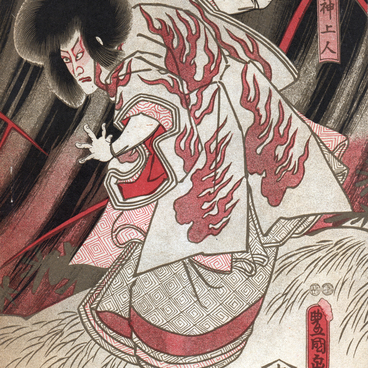In 1928 the Kabuki theater came to Moscow. Sergei Mikhailovich became friends with the leader of the troupe and with its actors, among whom Chôjûrô Kawarasaki stood out. The young luminary of ‘Kabukiza’, in his turn, was interested in Eisenstein’s works and visited the set of his film. This friendship between the “star” of Japanese theater and the innovative Soviet director was not an accident. Kawarasaki was among those who reinvented the art of Kabuki and brought its legacy into cinema. He was filmed by the great directors Sadao Yamanaka and Kenji Mizoguchi. In 1941, he played the role of ronin Kuranosuke Oishi in Mizoguchi’film Genroku Chûshingura (The 47 Ronin) based on one of the Kabuki plays which Sadanji’s troupe performed in Moscow. In his article “An Unexpected Juncture” (1929), Eisenstein wrote that the play Kanadehon Chûshingura suggested figurative use of sound in cinema to him.
1 / 7
Booklet on Japanese theater for its USSR tour
Creation period
Leningrad, 1928
Technique
Бумага, скрепка, полиграфическая печать
Collection
Exhibition
6
Open in app#1
Booklet on Japanese theater for its USSR tour
#2
#3
Eisenstein’s autograph
#4
On each book that he bought, usually on the flyleaf, Sergei Mikhailovich put his signature with the date and the place of purchase. These autographs are not just a chronicle of the life of a bibliophile; they reflected the stages of the creative life of the director and theorist.
Here is just one example.
In 1928–29, the following notes appear next to the date of acquisition: ‘GenLin, ” “GenLin 2,” “GenLin 3”… The notes mean that a certain book was bought when Eisenstein was working on The General Line. But what is the meaning of the numbers? After all, the film only had one episode!
“GenLin 2” (starting in February 1928) is, without a doubt, the return to the film after submitting October.
“GenLin 3” (May-August 1929) is the additional shooting of some episodes and the reworking of the film.
“GenLin 4” is the project of providing the film with music and sound during the business trip abroad approved by Stalin, since there was no necessary sound equipment in the USSR yet.’
Here is just one example.
In 1928–29, the following notes appear next to the date of acquisition: ‘GenLin, ” “GenLin 2,” “GenLin 3”… The notes mean that a certain book was bought when Eisenstein was working on The General Line. But what is the meaning of the numbers? After all, the film only had one episode!
“GenLin 2” (starting in February 1928) is, without a doubt, the return to the film after submitting October.
“GenLin 3” (May-August 1929) is the additional shooting of some episodes and the reworking of the film.
“GenLin 4” is the project of providing the film with music and sound during the business trip abroad approved by Stalin, since there was no necessary sound equipment in the USSR yet.’
read morehide
Booklet on Japanese theater for its USSR tour
Creation period
Leningrad, 1928
Technique
Бумага, скрепка, полиграфическая печать
Collection
Exhibition
6
Open in app
Share










